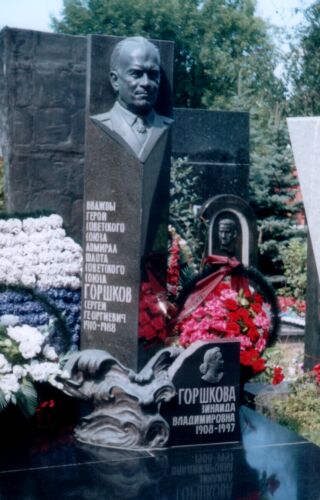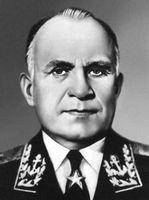05 January 2010
General Quarters!

I am a little cranky this morning. I was up early to see if I could find the pictures I took of Fleet Admiral Gorshkov’s tomb.
It was one of those serendipitous things. I hadn’t been looking for him, and happened across the Admiral a decade after this death on a pleasant Spring day in 1998 in the Novodevichy Cemetery outside Moscow.
I remember taking the pictures, and now they are vanished as certainly as the Old Soviet Union. Damn. They were good, and they showed a phlegmatic young American Naval Officer, just selected for Captain, toasting the great Adversary in one of the quiet moments of triumph. I’ll have to settle for this one.
Oh well.
I recall that the Admiral looked great, or at least the marble manifestation of him did. The graves of the Soviet Era notables are remarkable, fantastic even, in their artistic merit. Having no official God, the State bequeathed the very best of temporal eternity on those who had served it faithfully.
There was no more faithful son of Russian than Sergey Georgiyevich Gorshkov.
Many American military officers- Rex among them- regarded Gorshkov as an important contributor to modern naval strategy. The architect of Rex’s later career, Bu Zumwalt, described Gorshkov to the Washington Post in 1975 as “the most effective naval leader of modern times.”
Coming from the greatest Young Turk of the United States Navy, that is no faint praise.
For Rex, and for a generation or two of Naval Intelligence officers, Fleet Admiral Sergie Gorshkov defined the threat to our Homeland. Rex had collected intelligence in Moscow against his growing forces, and the Russians were a rising presence in the Med when he was the assistant CIC officer on the nuclear-armed cruiser Macon.
It is one of those practical facts of life in the national security business that nothing is ever complete before something else startling or downright frightening crops up. At the beginning of the new decade of the 1970s, the Nixon Administration was preoccupied with the duplicitous behavior of the North Vietnamese at the Paris peace talks, and became determined to settle their hash on the Ho Chi Minh trail as it paralleled the Vietnamese border in Laos and Cambodia.
Rex had been specifically commended for his efforts in building a network of human agents in Cambodia, and my pal Larry was there right then, stirring up all manner of righteous mischief, discovering in the process that the Russians had a SIGINT base just across the water, locating American communications by HF/DF, and copying everything that was said on the tactical radios.
We did not know that they were into our codes as well; that sinking revelation was not apparent until years later. But that is the nature of the intelligence game, and it is just our good fortune that we never had to go into a shooting war while the Soviets held that precious card.
Preparations for the incursion into Cambodia were well underway when the Soviets pulled a rabbit out of the hat that changed the strategic landscape utterly.
“Okean-70” (Ocean) was a worldwide demonstration of the growing might of the Soviet Navy. It was conducted symbolically on the 100th anniversary of Lenin’s birth. Submarines and surface combatants flooded our of bastion ports in the frozen depths of the Northern Fleet. Amphibious landings were conducted on the rugged coastline near Norway. A pair of long-range aviation TU-95 Bear Deltas deployed to Cuba after conducting surveillance and simulated anti-carrier attacks on US forces in the North Atlantic.
It was breathtaking. Alarming. Scary. The US arsenal of national technical collection means was focused on the flurry of activity. Allied units, mostly British and Norwegian frantically flew aircraft against the spreading web of Soviet ships. SOSUS arrays were inundated with acoustic information. Satellites revealed the piers along the inlets of the Kola Gulf were empty.
General Quarters, General Quarters!
The exercise was intended to convey formidable messages to external and internal audiences. For the West, it was a demonstration of implacable will and new capability.
Beyond the formidable (if noisy) number of nuclear subs and stylish surface units, one of the marvels of the Okean exercises was the revelation that everything that floated as a part of the Soviet State was fully integrated into the global warplan. We did not even imagine that merchant ships had sealed orders to proceed to designated points above the vast alluvial plains of the north Atlantic and drag their anchors just so- cutting acoustic calbes and rendering the American spies deaf and dumb.
There was spookier stuff, too, that we did not discover until years later. It was a magnificent display that the Russians were inside our system with a subtlety that was as astonishing as it was matter-of-fact.
For the Kremlin, the Okean exercises were proof that the vast treasure poured into the building of ships and submarines was worth the cost.
And of course it came with cost; Admiral Gorshkov was well aware that without pain there is no gain.
Émigré debriefs- one of the most important sources of intelligence back in the day of the Iron Curtain- revealed that one and possibly two nuclear submarines were lost in the forward deployment. Near the beginning of Okean, on 11 April, a November-class attack submarine suffered an internal fire and a possible nuclear propulsion system failure. Crewmen were seen by British maritime patrol assets on deck trying to rig a towline to a Soviet merchant ship, but because of worsening sea conditions, attempts to tow the sub had to be abandoned.
The number of crew casualties is not known, but it could have been everyone aboard, as many as eighty-eight.
Rex was about to take over Naval Intelligence with the nation fully engaged in a war that was spilling out of Vietnam and across all of Indochina. Back in Washington, he was confronting a Soviet fleet by a man who was called by some the twentieth-century equivalent of Alfred Thayer <http://www.globalsecurity.org/military/world/russia/gorshkov.htm#%23> Mahan.
Sergei Georgievich Gorshkov had managed to survive Stalin, Khrushchev, and Brezhnev to become one of the dominant figures in the Soviet military. More than a theorist, he was the architect of a new, assertive Soviet navy, and it was going to shape the last years of Rex’s career, and the first two decades of mine.
So that is 1970, the year Rex was selected to get a new name, the one he would carry the rest of his life: “Admiral.”
He would be taking over the helm of the oldest continuously operating intelligence organization in the United States. Across the metaphorical card table from Rex and his boss Bud Zumwalt was a worthy adversary: five time winner of the Order of Lenin, four time winner of the Order of the Red Banner and Hero of the Soviet Union Sergey Georgiyevich Gorshkov.

Copyright 2010 Vic Socotra
www.vicsocotra.com
Subscribe to the RSS feed!